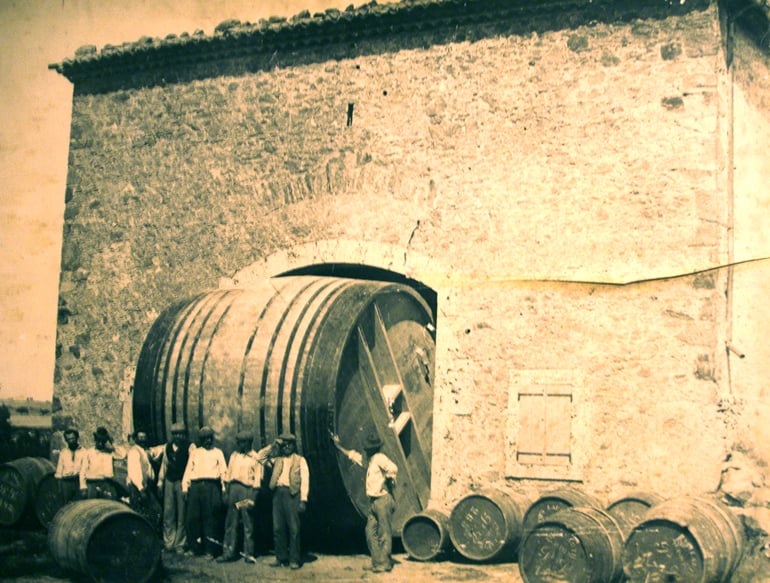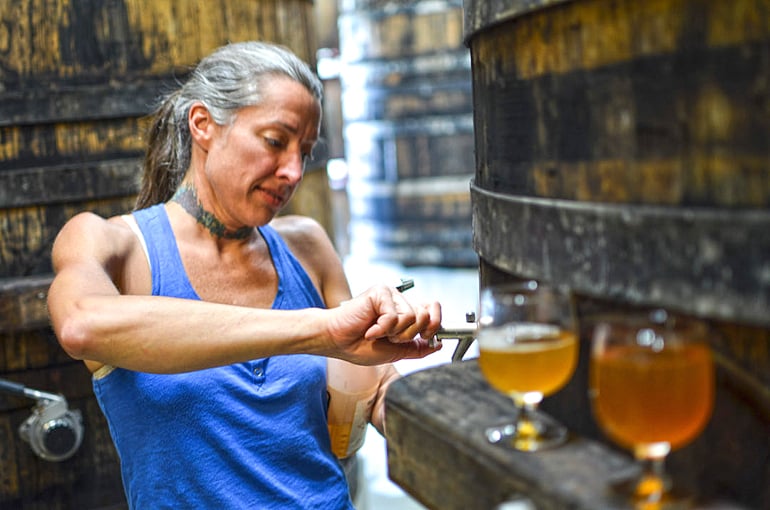Start 14-Day Trial Subscription
*No credit card required

What is a Foeder?
The Art of Coopering Part 2
Last time, we looked at what it takes to be a cooper – years of training, an intense attention to detail and a well-trained sensory toolkit amongst many other skills. But becoming a cooper is just the first step if you want to build a foeder.
Though they are more commonly found in the winemaking world, foeders have a celebrated beermaking tradition, championed by legendary European brewers such as Rodenbach, Brouwerij Boon and Liefmans, to name a few.
What is a foeder?
A foeder (prounounced food-er), in its simplest form, is a large barrel. When exactly it becomes a foeder rather than just an oversized barrel is somewhat discretionary, but the line is often drawn at 600 liters, which is around 160 gallons, or roughly three times the size of the average oak barrel.
Foeders are also distinguished by the lengths required to construct them. As we mentioned in Part I, foeders require a specially trained team of foudriers, which works together to complete the construction over a period of weeks, or even months, depending on the size of the vessel. (Editor’s Note: In France, foeder is written as “foudre”.) The world’s largest foeder belongs to the brewers of the aperitif Byrrh, in France. Though no longer operative, it once held up to 1 million liters, and required 200 trees over the course of 18 years to complete.

The time such a process takes leads to a special relationship between foudrieres (Editor’s Note: In France, foeder is written as “foudre”) and the vessels they birth, and the amount of detail required demands more than what is asked of a standard cooper. As described in Dick Cantwell and Peter Bouckaert’s luminous tome, Wood & Beer, the process is “more akin to artisanal construction than manufacture.”
The shape of a foeder may trend towards ovular or more cylindrical than the standard barrel shape. Some may even come with ornamental touches.
The obvious difference in size makes for a number of differences in foeder construction. Most notably, foeders usually have manways, allowing for access to the inside. This can make cleaning the inside a bit more comfortable, but it also means that staves must be sawn short, which can reduce the structural integrity of the vessel.
In fact, all staves for foeders must be sawn, rather than split, due to their size. Splitting wood is a more painstaking and less efficient process, but it preserves the medullary ray of the tree, making for a much hardier stave. Therefore, in foeder-making, extra care must be taken to preserve the grain and avoid knots. Aside from the manway, foeders are also far more likely to have other bells and whistles, such as permanently mounted spray balls, which can spout a variety of cleaning and preservative solutions within the foeder as needed. The shape of a foeder may trend towards ovular or more cylindrical than the standard barrel shape, as they are generally immobile and kept upright. Some may even come with ornamental touches.
“Foeder construction involves contemplation and patience in a kind of communion with the wood and the task at hand,” Cantwell writes. “A scaffolding is erected that encircles the work in progress and allows access by the foudriers… In various foeder works around France we saw artisans with tools and chins in hand, variously smoothing the channels for a manway, monitoring interior toasting, or disassembling a 13,208-gallon foeder bound for an Italian customer, each foudriere pondering exactly the right way to do it all. A typical foederie will turn out perhaps 200 tanks a year, compared with the spawn of tens of thousands – even hundreds of thousands, in some cases, of smaller barrels produced by their accompanying cooperages. Cranes and forklifts are needed to move them along the phases of their construction, as well as out the door once completed, a far cry from the benedictively dismissive roll along the way of the individual barrel.”
As Cantwell suggests, the movement of a foeder is a serious undertaking, and can be disastrous if not done with great care. Weeks of labor and thousands of dollars can be undone with a heavy hand. Often, foeders will have to be disassembled just to make it in the door, only to be painstakingly reassembled inside, as was the case for Anchorage Brewing Company’s Gabe Fletcher.

This foeder appears to be on its way out the door. Rolling a vessel of such size would likely require significant repair upon reaching its destination, though it may have been the only option the workers had.
Before moving a foeder, though, a brewer must acquire one. This is no small feat in itself, as supply far outstrips demand. Similar to the used-barrel market, craft brewers have historically bought foeders secondhand, most commonly from vintners who require fresh foeders for their wine. Or, the vintner will exchange a used foeder for a fresh one from the foederie for a discounted rate. The foederie can then resell the used foeder to a brewer for a premium, as the mellowed notes a used vessel imparts are often preferable to brewers.
One of a growing number of exceptions to the secondhand rule is Asheville’s Wicked Weed, whose Funkatorium is the East’s first and best sour and funk-only taproom. Founder and head brewer Walt Dickinson bought his first foeder from a California winery, with less-than satisfactory results. Since, he has resolved only to buy new foeders, choosing to purchase from Nadalié, a French cooperage.

Asheville-based Wicked Weed's Funkatorium, the funky jewel of the Southeast. (Photo Courtesy Wicked Weed)
Despite the added shipping costs, American buyers often preferred European coopers for their expertise and heritage. After all, they are the progenitors of the craft. But America has recently become home to its own foederie, and while there are cooperages in the U.S. that can maintain and repair, St Louis-based Foeder Crafters of America is the first of its kind.
The yankee foederie America was founded by Justin Saffell and Matt Walters, who have been crafting foeders from American White Oak for about two years, with vessels ranging in size from seven to 250 barrels, at a cost of $6,900 to $43,000 respectively. Though that may seem exorbitant, their prices are an estimated 20 percent cheaper than European competition, even without shipping cost.
So what does it mean to acquire a foeder? The cost of a foeder is just one of many considerations due to the large investment of resources and risk involved. One must understand the most intimate vagaries of the wood-aging process, and how they will differ from a barrel to a foeder. They must also have a firm grasp on the maturation and blending processes of foeder-beer, as it can quickly turn for worse – or better. Lastly, a brewer in possession of a foeder must know at least basic barrel maintenance, which becomes increasingly complicated as the size of the vessel increases, although not entirely different. Basically, anyone interested in acquiring a foeder should experiment with a standard barrel first; there’s just too much at stake.
Read The Art of Coopering Part 1: The Role of Coopering in Barrel-Aged Beers
Read The Art of Coopering Part 3: How to Craft a Barrel

New Belgium's wood cellar manager Lauren Salazar keeps a detailed log of each beer inside the brewery's 64 foeders – how they taste, their maturity level, and what they may blend with. (Photo Courtesy New Belgium)
Stay tuned for Part III, in which we'll discuss how barrels are made from tree to stave.



